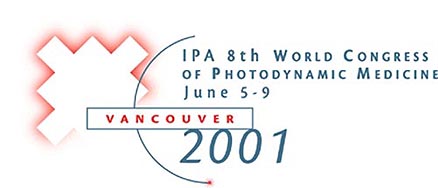Expanding
Horizons in PDT
Chair: Mohammad Azab
Over
the past several years, extensive research has been conducted to
evaluate photodynamic therapy for treatment of conditions in oncology,
ophthalmology, autoimmunity and cardiology. This symposium is designed
to acquaint PDT researchers and practitioners from a broad spectrum
of fields with the wide-ranging research and development efforts
that have been undertaken using verteporfin and other photosensitizers.
Dr.
Mohammad Azab, MD and Senior Vice-President, Clinical Research and
Medical Affairs for QLT will chair this symposium, during which
a panel of distinguished physicians and scientists will present
information on preclinical and clinical studies that have recently
been conducted within these four areas.
The
presentation agenda is as follows:.
16:00
– 16:30
Michael J. Potter, MD – Visudyne™ Therapy for the Treatment of Classic
and Occult Choroidal Neovascularization in Age-related Macular Degeneration
The wet form of age-related macular degeneration (AMD) is the
leading cause of legal blindness in people over the age of 50 in
the Western world. Results from the TAP and VIP studies have demonstrated
a significant treatment effect for verteporfin therapy in patients
with predominantly classic and occult CNV lesions. Two year follow-up
from both trials will be presented.
16:30
– 16:50
David Saperstein, MD – Clinical Trials Using Visudyne™ Therapy for
Choroidal Neovascularization Secondary to Pathologic Myopia (VIP
- PM Trial) and Ocular Histoplasmosis Syndrome (VOH Trial)
In this session, the effects on visual acuity of patients with subfoveal
choroidal neovascular membranes (CNV) in pathologic myopia (PM)
and ocular histoplasmosis syndrome (OHS) who were treated with verteporfin
will be presented.
16:50 – 17:05
Sandra Gollnick, PhD – Photodynamic Vaccination: Review and Data
Presentation
One of the potential advantages of photodynamic therapy over
other types of cancer treatment is its ability to enhance the host
anti-tumor immune response. Studies that have sought to exploit
the ability of PDT to enhance tumor immunogenicity by using PDT-generated
tumor cell lysates as tumor vaccines have shown that PDT vaccines
are effective at suppressing subsequent tumor growth via the generation
of tumor specific T-cells.
17:05
– 17:20
Nancy Oleinick, PhD – PDT in Signal Modulation and Apoptosis: Review
and Data Presentation
Photodynamic therapy produces localized oxidative damage in cells
at or near the intracellular site of photosensitizer binding, resulting
in oxidative stress that is highly efficient at activating cellular
signaling pathways and prompt apoptosis. This presentation will
review the evidence for the intersection of constitutive and PDT-regulated
pathways in PDT-induced apoptosis.
17:20
– 17:30
Philippe Margaron, PhD – Review of PDT in Cardiovascular Medicine
Researchers have explored photodynamic therapy as a modali-ty
for the reduction and stabilization of atherosclerotic plaques and
the inhibition of intimal hyperplasia, and a number of clinical
trials are underway. This presentation will first summarize the
scientific rationales for PDT in cardiovascular applications before
reviewing the approaches being investigated today by the groups
actively working in this field.
17:30
– 17:40
Harvey Lui, MD – Review of Verteporfin PDT in Skin Cancer
Historically PDT was first used for treating patients with skin
tumors, and this has been the case with verteporfin as well. Early
studies of patients with non-melanoma skin cancer confirmed the
short duration of systemic photosensitivity with verteporfin, while
demonstrating the potential for effective control of primary and
metastatic skin tumors. More recent studies have been designed to
explore the role of verteporfin-based PDT in patients with multiple
skin tumors in terms of both tumor eradication and cosmetic outcome.
17:40
– 18:00
Q & A
|

